To read the full report, please download PDF.
Past MoF interventions – success or failure?
FX View:
The US dollar is ending the week on the backfoot, weaker across all G10 currencies following the US employment report that was below market expectations, albeit not dramatically so. The reaction certainly reflects to a degree our view that the removal of much of the rate cut pricing in the US for this year has perhaps gone too far. The yen is the standout performer this week with the MoF highly likely to have intervened on two occasions to halt the depreciation of the yen. This week we take a closer look at the history of intervention in Japan and conclude that the often cited view that intervention “never” succeeds is not true. Past interventions were not always undertaken for precisely the same reasons and hence certain episodes should be viewed differently. We also look at GBP ahead of the BoE meeting next week and conclude that risks are skewed to the downside.
JPY SURGES TO TOP PERFORMER AFTER MOF ACTS
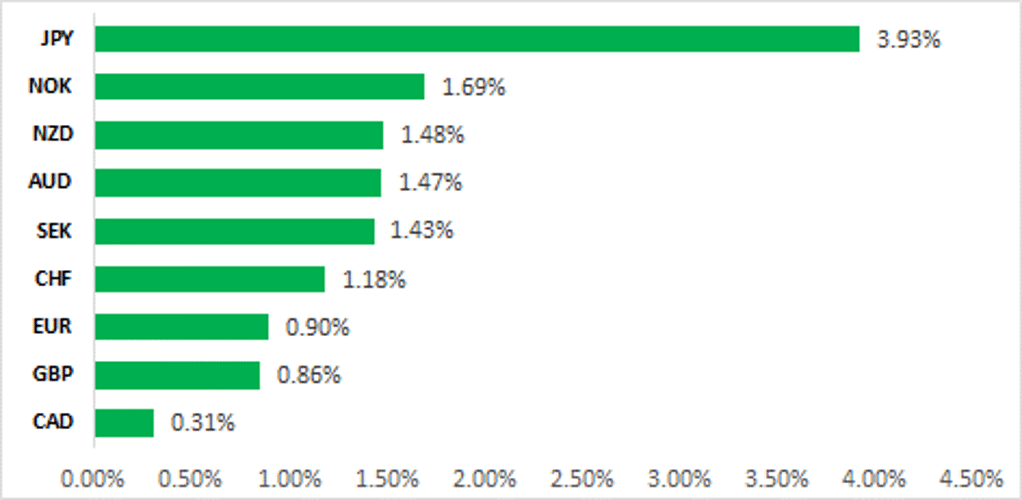
Source: Bloomberg, 13:50 BST, 3rd May 2024 (Weekly % Change vs. USD)
Trade Ideas:
We are recommending a new long EUR/GBP trade idea and are maintaining a long AUD/NOK trade idea.
JPY Flows – OTC Retail FX :
Following the probable intervention this week we take a look at the positioning in the OTC retail margin FX sector and conclude that positioning as of the end of March pointed to retail market participants may well have benefitted from JPY buying intervention.
Short Term Fair Value Modelling:
This week we monitor the relationship between spot and fair value for our JPY, GBP and EUR short-term regression models. We identify the convergence in the relationship between GBP/USD and the calculated fair value where GBP/USD has appreciated to in recent weeks and is currently overvalued by 0.29%. Whilst our USD/JPY and EUR/USD fair value models identify mis-valuations of -0.96% and -0.21% respectively.
FX Views
JPY: Intervention in the past more successful than widely assumed?
The roughly 5-big figure moves lower in USD/JPY on Monday in Asia trading and again on Wednesday evening at the end of the New York trading session was highly likely to have been intervention by the MoF in Tokyo and debate is now focused on whether or not the intervention from the MoF can prove successful. Clearly the authorities have chosen a ‘cloak-and-dagger’ strategy of refusing to confirm the action which means waiting until we get the monthly intervention data on 31st May. As widely reported, BoJ current account projected versus actual balances suggest potentially around JPY 9trn worth of JPY sales. That would be close to the September/October 2022 interventions combined. While there are always differences in conditions in each period of intervention there is a widespread belief in the markets that the MoF has a history of failure when it comes to intervention. Is this correct? And should all previous interventions be judged in a similar way?
Looking back at the history of intervention in Japan since mild deflation began in 1995 there have been five distinct periods of intervention to sell the yen (1995-96; 1999-2000; 2001; 2002-04; and 2010-11) with some of those interventions incentivised for slightly different reasons. There have been three distinct periods (including now) of yen buying (1997-98; 2022; 2024) Some of the yen selling periods were long with considerable activity intervening to sell the yen. Over those five periods of yen selling, the MoF intervened on no fewer than 218 separate days. The bulk of yen sales were for US dollars although there were some euro purchases as well (when EUR was trading close to record lows). Covering the three yen buying intervention periods, the MoF has intervened on 11 separate days (assuming this week was intervention!) and all were selling the US dollar. Since 1995, the MoF through intervention has sold just over 76trn while yen buying intervention has totalled around JPY 22trn (assuming JPY 9trn this week). Taking the average USD/JPY rate over each intervention period and weighting to intervention activity, we arrive at an average purchase rate over all interventions since 1995 of 109.00. Similarly, a weighted average of all JPY buying gives us a rate of 141.00.
These calculations give us a US dollar accumulation of just under USD 700bn over the period since 1995 with sales of a little over USD 150bn. Over that period of time of course there has been a considerable positive carry on this position given the battle against deflation in Japan has kept interest rates at close to zero percent while the US has gone through three economic and monetary policy cycles.
USD/JPY PERFORMANCES (REBASED 100) POST JPY SELLING INTERVENTION 12MTH PERIODS

Source: Bloomberg, Macrobond & MUFG GMR
USD/JPY PREFORMANCES (REBASED 100) POST JPY BUYING INTERVENTION 12MTH PERIODS

Source: MUFG & Global Markets Research
While we can argue from that perspective that intervention has been fruitful during a time of near zero rates in Japan we also need to look at whether intervention actually helps turn USD/JPY while also being mindful that a turning point is not necessarily down to intervention alone. Analysing USD/JPY performance from the final date of intervention in each of the yen selling intervention periods the results are quite compelling in pointing to turning USD/JPY. Over a 6mth period, USD/JPY is higher in all periods; over a 12mth period is higher in four out of five times; and over a 24mth period is higher again in four out of five times. In the two yen buying intervention periods, USD/JPY is lower in both times over 6mths; down in one and unchanged in one over 12mths; and down in the 1998 example over 24mths. The current period of intervention overlaps in the 24mth period from 2022 as does some of the yen selling periods but certainly over a 12mth period there is clear evidence from past performance that intervention marks a turning point. Again we can debate the reason for the turn being other than intervention (fundamentally driven) but we would argue that the MoF is aware of the fundamentals too and may choose their moments based on being close to potential turns in the fundamental backdrop.
In addition, we would argue that there should be less emphasis on FX direction as a measure of success on some of the intervention periods. In September 2001 for example, the MoF intervened 7 times following 9/11 which was viewed as a source of helping stabilise financial markets more generally. In addition, the period of 2002-04 coincided with the policy rate in Japan hitting 0.10% and the BoJ announcing a new monetary policy framework that moved away from a targeted interest rate to targeting the sum of required and excess reserves. Yen selling intervention was part of this domestic monetary policy strategy as it helped boost excess reserves held at the BoJ. Over a 12mth period of USD/JPY performance following intervention periods, it is only the 2002-04 period in which USD/JPY failed to turn higher. These two periods (2001 & 2002-04) are also the two periods of intervention where the level of USD/JPY buying was at notably higher levels than intervention in the other periods and hence we would argue point to other ulterior motives for intervention beyond purely influencing the JPY exchange rate weaker.
Certainly when you look at the levels in USD/JPY when intervention takes place beyond the 2001 and 2002-04 periods, the levels are on a weighted average below 100.00 in USD/JPY and above 140.00 in yen buying periods and those episodes were certainly a lot more specific to halting either yen moves stronger or weaker.
USD/JPY PERFORMANCES (REBASED 100) POST JPY SELLING INTERVENTION 24MTH PERIODS
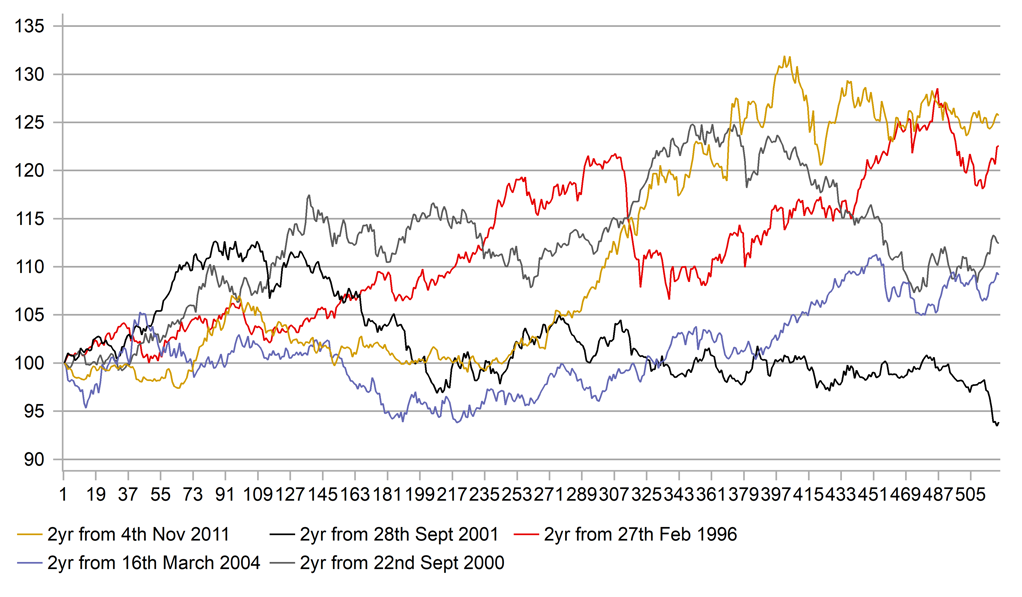
Source: Bloomberg, Macrobond & MUFG GMR
MOF YEN BUYING AND YEN SELLING INTERVENTIONS SINCE 1995 TO APR 2024
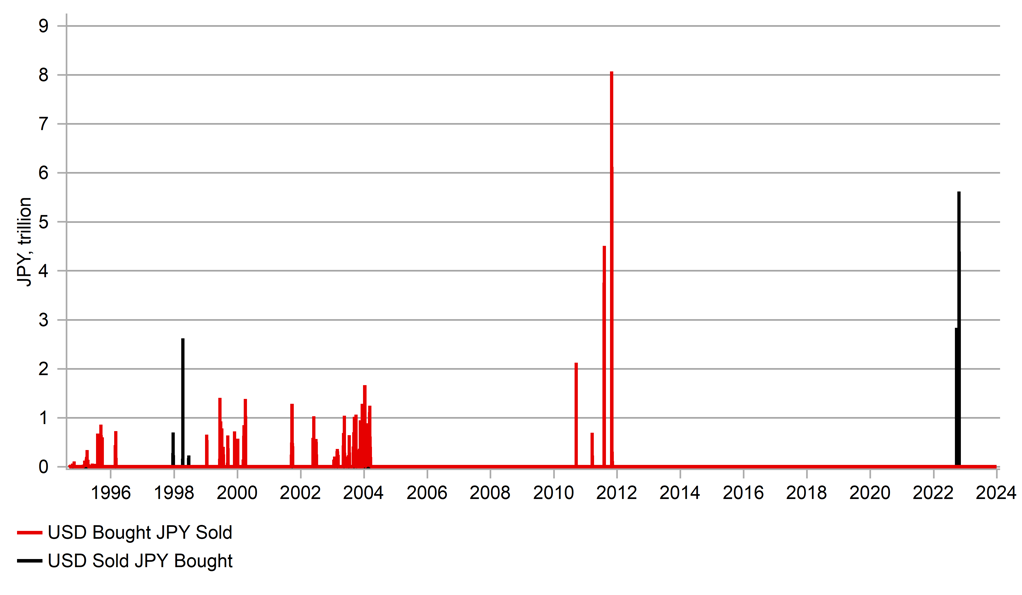
Source: Bloomberg, Macrobond & MUFG GMR
Assessing the five yen selling intervention periods, over a 6mth period following the final bout of intervention, USD/JPY is higher on every occasion by an average of 6.5%. Over a 12mth period, USD/JPY is higher on four periods by an average of 7.4% (range 2.1% to 17.1%) with the 2002-04 period recording a loss of 3.6%. Over a 24mth period, USD/JPY is higher in four periods by an average of 17.5% (range +9.2% to +25.5%) with only the 2001 period recording a loss of 6.1%. You may wish to argue here that the USD/JPY performance following these interventions were down to fundamentals and we would tend to agree but that shouldn’t take away from the significance of the post-intervention performances. It at least points to the MoF timing its interventions well (bar 2001 and 2002-04 periods of course explained above when USD/JPY declined – one in the 12mth period and one in the 24mth period). It also begs the question, what evidence other market participants are looking at in relation to Japan who state that intervention “never” works.
Taking this analysis today there is a caveat in simply assuming recent intervention marks a turning point. As highlighted here last week, the current monetary stance in Japan is at an extreme and reflecting the highest level of inflation since the early 1990’s we now have a real terms BoJ policy rate of over -200bps in contrast to the nearly +200bps in the US. (we should exclude high inflation periods due to Sales tax increases in 1997-98 and 2014). The fact that the MoF is intervening again now at higher levels than in 2022 does point to greater difficulties than in past intervention periods in halting the JPY trend that warrants a degree of caution in suggesting we are now at a turning point. Still, if this an indication once again of the MoF at least timing well the potential for a turning point in the fundamental backdrop, it is certainly something we concur with. We still see scope for the Fed to commence cutting rates in July which could mean at least three rate cuts are delivered this year, a lot more than currently priced. In addition, we see as quite plausible a scenario of a rate cut by the Fed on 31st July which is the very same day of the BoJ meeting that will take place earlier that day and is when we currently expect the BoJ to hike its key policy rate by 15bps to a range of 0.15%-0.25%. Such a scenario is not currently expected and is much more plausible than currently assumed which taken in combination with the intervention currently taking place could potentially be quite powerful in helping turn the USD/JPY trend.
BOJ POLICY RATE 1YR & 2YR FORWARD HEADING HIGHER IN NOMINAL TERMS
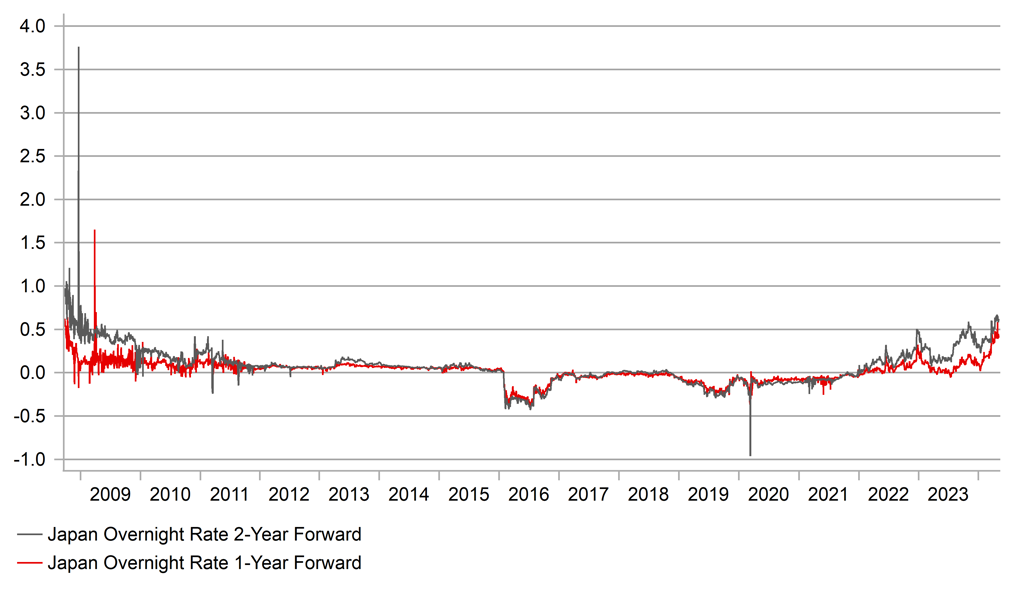
Source: Bloomberg, Macrobond & MUFG GMR
JPY BUYING INTERVENTION & BOJ POLICY RATE IN REAL TERMS – RECORD NEGATIVE REAL POLICY RATE
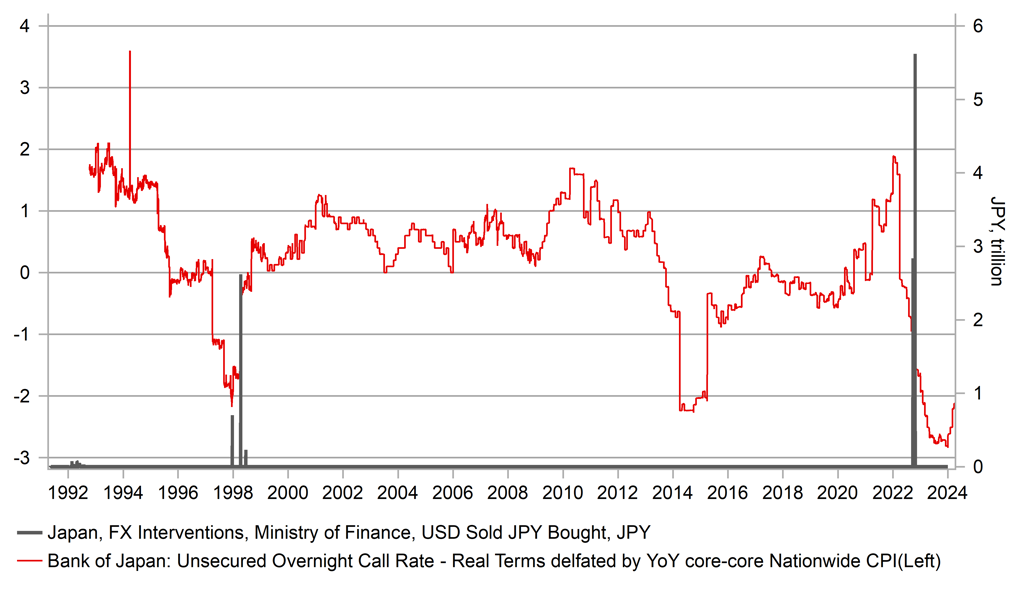
Source: Bloomberg, Macrobond & MUFG GMR
GBP: Weighing up downside risks for GBP from next week’s MPC meeting
The GBP has been one of the best performing G10 currencies so far this year. After the USD, the GBP has been the second best performer. It has helped cable to hold up better against broad-based USD strength. After falling to a year to date low of 1.2300 on 22nd April, cable has since climbed back up to within touching distance of the 200-day moving average at 1.2570 and moved back to the middle of the 1.2000-1.3000 range that has been in place over the past year. Similarly, the GBP has recovered lost ground against the EUR as well in recent weeks resulting in EUR/GBP moving back towards the middle of the narrow trading range between 0.8500 and 0.8600 that has been in place for most of this year. The GBP like the EUR has been supported in recent weeks by building evidence of strengthening cyclical momentum in Europe. The mild technical recession in the UK at the end of last year appears to have been short-lived. UK GDP growth is on track to exceed the BoE staff forecast of 0.1% for Q1, and growth momentum appears to be strengthening further at the start of Q2.
The recent run of stronger UK activity data and the upside inflation surprise in March alongside the spill-over impact from the Fed’s hawkish shift in policy guidance signalling a delayed start to rate cuts, has encouraged UK rate market participants to push back the expected timing of the BoE’s first rate cut until the August or September MPC meetings. The probability of an earlier rate cut either next week or in June is currently judged as much less likely now with only around 10bps of cuts priced in by June. However, we do not expect the recent data flow to prevent the BoE from delivering a more dovish policy signal next week indicating they are moving closer to cutting rates.
While the BoE is expected to leave the policy rate on hold at 5.25% in the week ahead, recent comments from MPC officials have indicated that more MPC members may join arch dove Swati Dinghra in voting for a rate cut. Deputy Governor Dave Ramsden is the most likely candidate given he recently judged that risks to the BoE’s inflation forecasts are now “titled to the downside”. He expressed a similar view to Governor Bailey in having more confidence that the UK appears less of an outlier in terms of higher inflation than in other major economies, and now appears more of a laggard with inflation set to slow further this year. The shift in the balance of risks should be captured in the updated inflation projections in next week’s Quarterly Inflation Report. We expect the updated forecasts to indicate a lower probability of inflation overshooting the BoE’s inflation target over the forecast period. In light of these developments, we have held on to our forecast for the BoE to begin cutting rates sooner in June (click here). A more dovish BoE policy update poses downside risks for the GBP in the week ahead.
GBP/USD VS. SHORT-TERM YIELD SPREAD

Source: Bloomberg, Macrobond & MUFG GMR
A MORE DIVIDED MPC?

Source: Bloomberg
One complication for the BoE when setting monetary policy has been recent evidence of tightening liquidity in the UK that could contribute to a further unwanted tightening of the BoE’s policy stance. The tightening of liquidity conditions is evident by banks increased usage of the BoE’s short-term repo facility where demand reached a record high of GBP12.2 billion this week. It has been placing additional upward pressure on short-term money market rates in the UK. The latest developments have encouraged speculation that the BoE may need to slowdown the pace of quantitative tightening similar to the Fed. The BoE’s current annual program has committed to reducing the stock of UK government bond holdings by GBP100 billion in the year to September. The timing of emerging tightening liquidity conditions is somewhat surprising given that the BoE’s balance sheet remains relatively elevated. Reserve balances at the BoE have declined to around GBP770 billion from a peak of GBP979 billion in 2022 but remain well above pre-COVID levels at around GBP480 billion. BoE executive director Andrew Hauser had indicated last year that the preferred minimum range of reserves would be between GBP335 billion and GBP495 billion so it is somewhat surprising to already see clearer signs of tightening liquidity at current reserve levels. In the near-term we see no significant implications for GBP performance although at the margin it could weigh on the GBP later this year if the BoE alters plans to slow the pace of QT beyond September.
In light of these developments, we judge that risks are titled to the downside in the near-term for the GBP. Further evidence that the BoE is moving closer to cutting rates could trigger a weaker GBP moving it back towards the bottom of current trading ranges against the EUR and USD. However, improving cyclical momentum for the UK economy and still supportive conditions for higher yielding carry currencies should prevent a sharper sell-off for the GBP. Historically the GBP has tended to underperform in the month of May most notably between 2010 and 2020 when cable declined for eleven consecutive calendar years, although performance has been more mixed in the years following the COVID shock.
INCREASING USE OF BOE’S SHORT-TERM REPOS
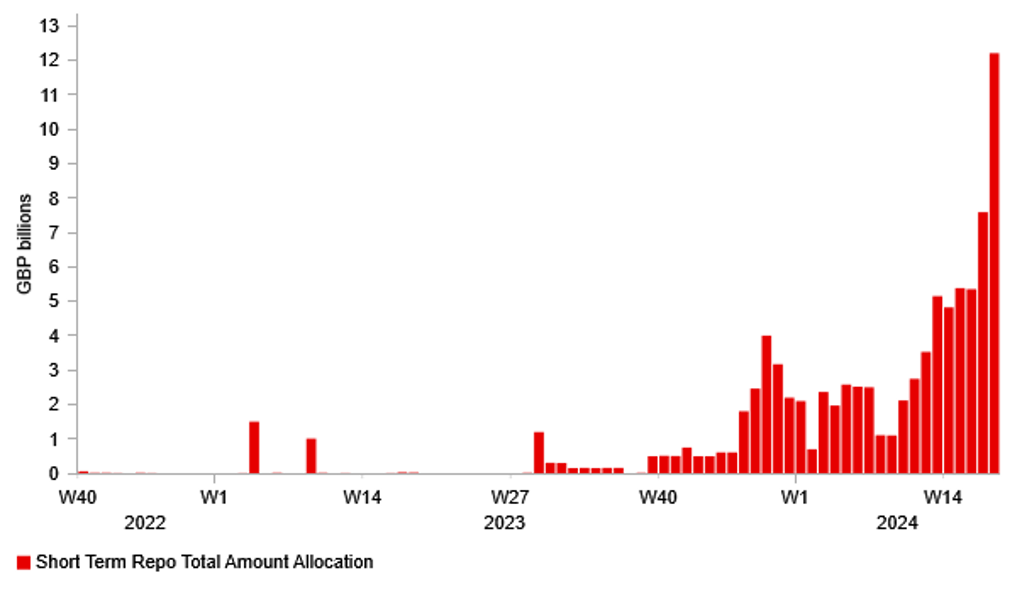
Source: Bloomberg, Macrobond & MUFG GMR
UPWARD PRESSURE ON SHORT-TERM UK RATES
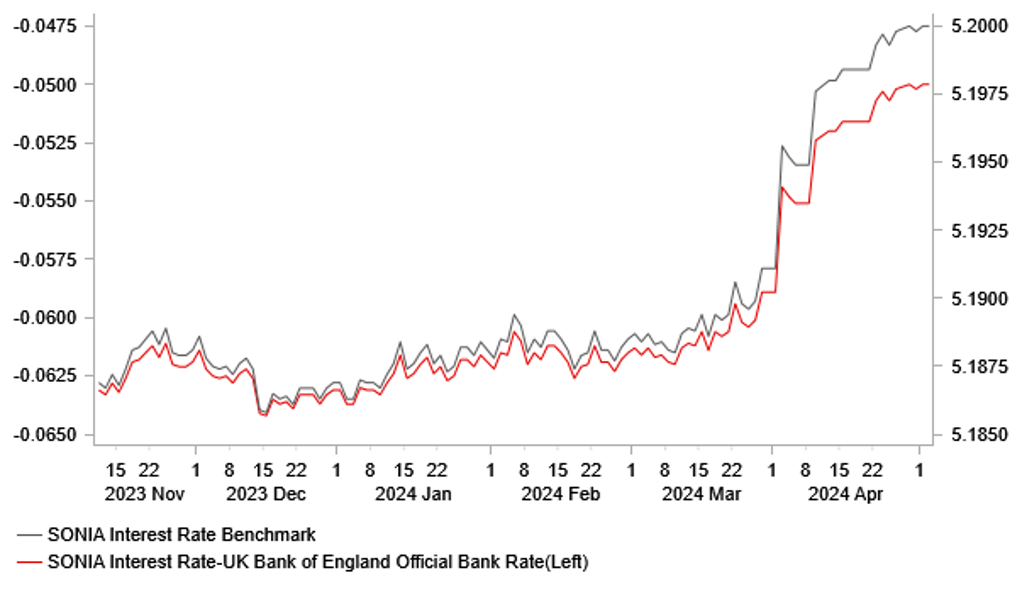
Source: Bloomberg, Macrobond & MUFG GMR
Weekly Calendar
|
Ccy |
Date |
BST |
Indicator/Event |
Period |
Consensus |
Previous |
Mkt Moving |
|
EUR |
05/06/2024 |
09:00 |
HCOB Eurozone Services PMI |
Apr F |
-- |
52.9 |
!! |
|
EUR |
05/06/2024 |
09:30 |
Sentix Investor Confidence |
May |
-- |
-5.9 |
!! |
|
EUR |
05/06/2024 |
10:00 |
PPI YoY |
Mar |
-- |
-8.3% |
!! |
|
USD |
05/06/2024 |
18:00 |
Fed's Williams Participates in Fireside Chat |
!!! |
|||
|
USD |
05/06/2024 |
19:00 |
SLOOS on Bank Lending Practices |
!!! |
|||
|
AUD |
05/07/2024 |
02:30 |
Retail Sales Ex Inflation QoQ |
1Q |
-0.2% |
0.3% |
!! |
|
AUD |
05/07/2024 |
05:30 |
RBA Cash Rate Target |
4.35% |
4.35% |
!!! |
|
|
EUR |
05/07/2024 |
07:00 |
Germany Factory Orders MoM |
Mar |
-- |
0.2% |
!! |
|
EUR |
05/07/2024 |
07:00 |
Germany Trade Balance SA |
Mar |
-- |
21.4b |
!! |
|
EUR |
05/07/2024 |
07:45 |
France Wages QoQ |
1Q P |
-- |
0.4% |
!!! |
|
EUR |
05/07/2024 |
10:00 |
Retail Sales MoM |
Mar |
-- |
-0.5% |
!! |
|
EUR |
05/08/2024 |
07:00 |
Germany Industrial Production SA MoM |
Mar |
-- |
2.1% |
!! |
|
SEK |
05/08/2024 |
08:30 |
Riksbank Policy Rate |
4.00% |
4.00% |
!!! |
|
|
GBP |
05/09/2024 |
00:01 |
RICS House Price Balance |
Apr |
-- |
-4.0% |
!! |
|
JPY |
05/09/2024 |
00:30 |
Labor Cash Earnings YoY |
Mar |
1.4% |
1.8% |
!!! |
|
GBP |
05/09/2024 |
12:00 |
Bank of England Bank Rate |
5.25% |
5.25% |
!!! |
|
|
GBP |
05/09/2024 |
12:30 |
BOE Governor Press Conference |
!!! |
|||
|
USD |
05/09/2024 |
13:30 |
Initial Jobless Claims |
-- |
-- |
!! |
|
|
JPY |
05/10/2024 |
00:30 |
Household Spending YoY |
Mar |
-2.3% |
-0.5% |
!! |
|
JPY |
05/10/2024 |
00:50 |
BoP Current Account Adjusted |
Mar |
¥2044.2b |
¥1368.6b |
!! |
|
GBP |
05/10/2024 |
07:00 |
GDP QoQ |
1Q P |
-- |
-0.3% |
!!! |
|
NOK |
05/10/2024 |
07:00 |
CPI YoY |
Apr |
-- |
3.9% |
!! |
|
GBP |
05/10/2024 |
07:00 |
Trade Balance GBP/Mn |
Mar |
-- |
-£2291m |
!! |
|
GBP |
05/10/2024 |
12:15 |
BOE's Huw Pill speaks |
!!! |
|||
|
EUR |
05/10/2024 |
12:30 |
ECB Publishes Account of April Meeting |
!! |
|||
|
CAD |
05/10/2024 |
13:30 |
Net Change in Employment |
Apr |
20.0k |
-2.2k |
!!! |
|
USD |
05/10/2024 |
15:00 |
U. of Mich. Sentiment |
May P |
77.0 |
77.2 |
!! |
Source: Bloomberg, Macrobond & MUFG GMR
Key Events:
- There is a busy schedule of G10 central bank policy updates in the week ahead. The RBA (Wed), Riksbank (Thurs) and Bank of England all hold their latest policy meetings.
- The RBA is expected to leave their policy rate unchanged at 4.35% for the fourth consecutive meeting. Market participants will be watching closely to see if the RBA provides a more hawkish policy signal that opens the door to another rate hike if needed. At their last policy meeting in March, the RBA added that they were “not ruling anything in or out”. After the recent stronger CPI report for Q1, the Australian rate market is no longer expecting the RBA to cut rates this year.
- We expect the Riksbank to begin lowering rates by 0.25 point to 3.75% in the week ahead. At their last policy meeting, the Riksbank that they would cut rates in either May or June. The case for a rate cut has since been reinforced by weaker than expected inflation in March, a sharper increase in the unemployment rate in March and a preliminary estimate that Sweden’s economy likely contracted for the fourth consecutive quarter in Q1. The weaker krona will make the Riksbank more cautious over lowering rates but we don’t think it will be sufficient to delay a cut.
- The BoE’s upcoming policy meeting will be scrutinized closely to assess how much closer the BoE has moved to cutting rates. While the BoE is expected to leave rates on hold in the week ahead, it is possible that that at least one more MPC member may vote in favour of a rate cut. Deputy Governor Ramsden stated recently that he now judges risks as titled to the downside for inflation and could join arch dove Swati Dhingra in voting for a rate cut. We expect the BoE’s updated inflation projections to signal less concern over upside inflation risks in the coming years. The update should indicate that the UK rate market is currently underestimating the amount of BoE rate cuts.

